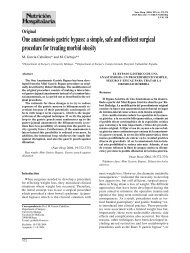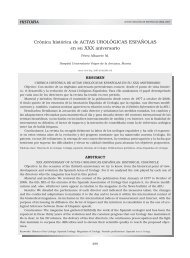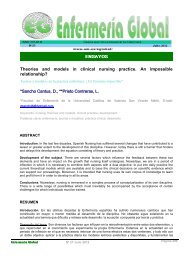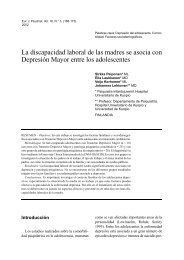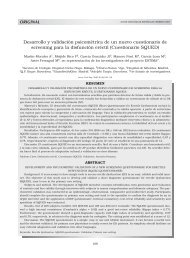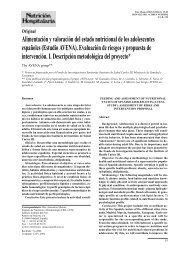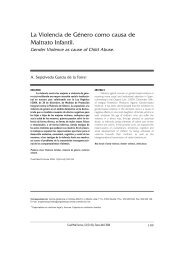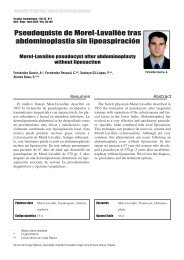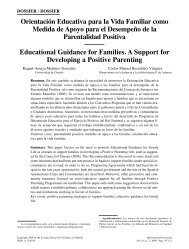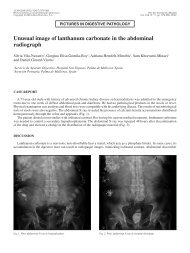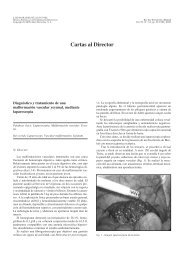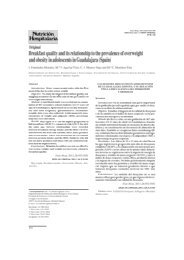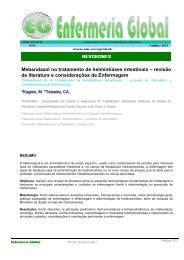How patients built up the practice of the lay homeopath Clemens ...
How patients built up the practice of the lay homeopath Clemens ...
How patients built up the practice of the lay homeopath Clemens ...
Create successful ePaper yourself
Turn your PDF publications into a flip-book with our unique Google optimized e-Paper software.
<strong>How</strong> <strong>patients</strong> <strong>built</strong> <strong>up</strong> <strong>the</strong> <strong>practice</strong> <strong>of</strong> <strong>the</strong> <strong>lay</strong><br />
<strong>homeopath</strong> <strong>Clemens</strong> von Bönninghausen.<br />
Quantitative and qualitative aspects <strong>of</strong> patient<br />
history<br />
Marion Baschin (*)<br />
(*) Institut für Geschichte der Medizin der Robert Bosch Stiftung, Stuttgart.<br />
marion.baschin@igm-bosch.de<br />
Dynamis Fecha de recepción: 12 de febrero de 2010<br />
[0211-9536] 2011; 31 (2): 475-495 Fecha de aceptación: 27 de julio de 2010<br />
SUMARIO: 1.—Introduction. 2.—The <strong>homeopath</strong> and his journals. 3.—The <strong>practice</strong>. 4.—The<br />
<strong>patients</strong>. 5.—The illnesses. 6.—Conclusions.<br />
ABSTRACT: Statistics seem to give little information about individuals’ fates. With <strong>the</strong> help <strong>of</strong><br />
patient journals, <strong>the</strong> interwoven connections between quantitative and qualitative aspects <strong>of</strong><br />
historical research work can be shown. This example focuses on <strong>the</strong> <strong>patients</strong> who, between<br />
1829 and 1864, <strong>built</strong> <strong>up</strong> <strong>the</strong> <strong>practice</strong> <strong>of</strong> <strong>the</strong> <strong>lay</strong> <strong>homeopath</strong> <strong>Clemens</strong> Maria Franz von Bönninghausen<br />
in Münster, Westphalia. Questions <strong>of</strong> <strong>practice</strong>, <strong>the</strong> social structure <strong>of</strong> <strong>the</strong> clientele,<br />
and <strong>the</strong> diseases Bönninghausen treated are also considered.<br />
KEY WORDS: Homeopathy, medical <strong>practice</strong>, patient history, quantitative and qualitative analysis.<br />
PALABRAS CLAVE: Homeopatía, práctica médica, historia del paciente, análisis cuantitativo<br />
y cualitativo.<br />
1. Introduction (*)<br />
On <strong>the</strong> 26th August 1849, Christine, a 24 year-old, went to <strong>the</strong> house <strong>of</strong><br />
<strong>Clemens</strong> Maria Franz von Bönninghausen. She did not have a severe illness.<br />
(*) The data presented in this paper come from my doctoral <strong>the</strong>sis which was s<strong>up</strong>ported by <strong>the</strong><br />
Studienstiftung des deutschen Volkes e. V. Some <strong>of</strong> <strong>the</strong> figures have already been used in a<br />
paper given at <strong>the</strong> conference «Methods in Theory and Practice. A conference for research<br />
students in History <strong>of</strong> Medicine and Allied Sciences» which took place in London on 25th and<br />
26th June 2009, and which gave <strong>the</strong> idea for this article. See: The Wellcome Trust Centre for<br />
<strong>the</strong> History <strong>of</strong> Medicine at UCL. Methods2009.eu [<strong>up</strong>dated 2 June 2009; cited 1 August 2010].<br />
Available from http://www.methods2009.eu/index.html.
476<br />
Marion Baschin<br />
Dynamis 2011; 31 (2): 475-495<br />
According to her complaints, she only had some premenstrual pains, a dry<br />
throat, and aching legs, and she was very thirsty.<br />
<strong>Clemens</strong> von Bönninghausen was a <strong>lay</strong> <strong>homeopath</strong> who <strong>practice</strong>d in<br />
Münster in Westphalia. Although he had never studied medicine, he was<br />
allowed to treat people <strong>homeopath</strong>ically thanks to an extraordinary permission<br />
granted by <strong>the</strong> Prussian king in 1843. Bönninghausen left more<br />
than 116 journals testifying to his medical <strong>practice</strong>. These records contain<br />
details about all <strong>the</strong> <strong>patients</strong> and <strong>the</strong>ir illnesses he had treated during his<br />
career as a <strong>lay</strong> <strong>homeopath</strong> between 1829 and 1864. These casebooks <strong>of</strong>fer<br />
<strong>the</strong> opportunity to demonstrate <strong>the</strong> interwoven connections between quantitative<br />
and qualitative aspects <strong>of</strong> research work, especially in <strong>the</strong> field <strong>of</strong><br />
patient history and <strong>the</strong> history <strong>of</strong> medical <strong>practice</strong> 1 .<br />
If <strong>the</strong> history <strong>of</strong> medical <strong>practice</strong> is considered, a lot <strong>of</strong> questions arise 2 .<br />
<strong>How</strong> busy was <strong>the</strong> doctor? <strong>How</strong> many <strong>patients</strong> did he see during a day or<br />
a year? Who were his <strong>patients</strong>? Which illnesses did he treat? The answers<br />
to <strong>the</strong>se questions partly consist <strong>of</strong> statistics reporting consultation rates<br />
per day, describing <strong>the</strong> clientele by percentages <strong>of</strong> socio-statistical features,<br />
or ranking illnesses according to <strong>the</strong>ir quantities. Amony all <strong>of</strong> <strong>the</strong>se<br />
numbers, <strong>the</strong> individuals, <strong>the</strong> <strong>patients</strong>, who form <strong>the</strong> core <strong>of</strong> patient history,<br />
as Christine did, seem to have vanished. This article <strong>the</strong>refore shows how<br />
<strong>patients</strong> build <strong>up</strong> a medical <strong>practice</strong>. It demonstrates that <strong>the</strong>re is no medical<br />
<strong>practice</strong> without sick people and <strong>the</strong>ir decision to see a certain healer.<br />
The research <strong>of</strong> <strong>the</strong> casebooks in this article is focused on <strong>the</strong> <strong>patients</strong> and<br />
1. These journals are kept in <strong>the</strong> archive <strong>of</strong> <strong>the</strong> Institute for <strong>the</strong> History <strong>of</strong> Medicine <strong>of</strong> <strong>the</strong><br />
Robert Bosch Foundation in Stuttgart (IGM). They have <strong>the</strong> signature P 1 to P 116. The initial<br />
article for research in <strong>patients</strong> and <strong>the</strong>ir history was: Porter, Roy. The patient’s view. Doing<br />
medical history from below. Theory and Society. 1985; 14: 175-198. An overview about<br />
patient history in medical history in general is <strong>of</strong>fered by Wolff, Eberhard. Perspectives on<br />
<strong>patients</strong>’ history. Methodological considerations on <strong>the</strong> example <strong>of</strong> recent German-speaking<br />
literature. Canadian Bulletin <strong>of</strong> Medical History. 1998; 15: 207-228 and Eckart, Wolfgang;<br />
Jütte, Robert. Medizingeschichte. Eine Einführung. Cologne/Weimar/Vienna: Böhlau; 2007, p.<br />
181-190. More literature concerning <strong>patients</strong> in <strong>homeopath</strong>y in Stollberg, Gunnar. Patients<br />
and <strong>homeopath</strong>y. An overview <strong>of</strong> sociological literature. In: Dinges, Martin, ed. Patients in<br />
<strong>the</strong> history <strong>of</strong> <strong>homeopath</strong>y. Sheffield: European Association for <strong>the</strong> History <strong>of</strong> Medicine and<br />
Health Publications; 2002, p. 317-329.<br />
2. As examples for such questions see Duffin, Jacalyn. Langstaff. A nineteenth-century medical<br />
life. Toronto/Buffalo/London: University <strong>of</strong> Toronto Press; 1999; and more recently Dietrich-<br />
Daum, Elisabeth; Dinges, Martin; Jütte, Robert; Roilo, Christine, eds. Arztpraxen im Vergleich.<br />
18.-20. Jahrhundert. Innsbruck/Vienna/Bolzano: Studienverlag; 2008.
<strong>How</strong> <strong>patients</strong> <strong>built</strong> <strong>up</strong> <strong>the</strong> <strong>practice</strong> <strong>of</strong> <strong>the</strong> <strong>lay</strong> <strong>homeopath</strong> <strong>Clemens</strong> von Bönninghausen<br />
Dynamis 2011; 31 (2): 475-495<br />
refers to <strong>the</strong> example <strong>of</strong> <strong>the</strong> journals <strong>of</strong> <strong>the</strong> <strong>lay</strong> <strong>homeopath</strong> <strong>Clemens</strong> Maria<br />
Franz von Bönninghausen 3 .<br />
2. The <strong>homeopath</strong> and his journals<br />
<strong>Clemens</strong> Maria Franz von Bönninghausen was born in March 1785.<br />
He studied law and later worked for Louis Napoleon, <strong>the</strong> King <strong>of</strong> The<br />
Ne<strong>the</strong>rlands. When Louis Napoleon abdicated in 1810, Bönninghausen<br />
returned to his home region <strong>of</strong> Westphalia. He worked <strong>the</strong>re for <strong>the</strong> Prussian<br />
administration and earned his living as a member <strong>of</strong> <strong>the</strong> land registry<br />
service («Katasterkontrolleur»). He was also very interested in botany<br />
and agriculture. In 1828, he became so gravely ill that all his friends and<br />
even all <strong>the</strong> physicians he consulted thought he would not survive. So he<br />
wrote a goodbye message to a friend who was, without Bönninghausen’s<br />
knowledge, also a <strong>homeopath</strong>ic doctor, <strong>the</strong> very first in Westphalia. The<br />
friend advised him <strong>of</strong> possible remedies and Bönninghausen recovered.<br />
Due to this miraculous healing, Bönninghausen became interested in<br />
<strong>the</strong> healing method that saved his life, and studied it himself. In 1829 he<br />
started his first <strong>of</strong>ficial casebook named: «Trials in Homeopathic Healing»<br />
(«Homöopathische Heilungs-Versuche»). His first patient was <strong>the</strong> famous<br />
German poetess Annette von Droste-Hülsh<strong>of</strong>f. More <strong>patients</strong> followed, but,<br />
as Bönninghausen had never studied medicine and was not legally approved<br />
as a physician, his treatments soon provoked an unfavourable reaction. In<br />
1836 <strong>the</strong> Prussian Government prohibited him from practicing <strong>homeopath</strong>y,<br />
but he never stopped his work and kept on treating those who sought his<br />
3. The casebooks <strong>of</strong> doctors are valuable indirect sources for patient history. There have only<br />
been a few works researching a medical <strong>practice</strong> through focusing on <strong>the</strong> <strong>patients</strong>. Especially:<br />
Baal, Anne van. In search <strong>of</strong> a cure. The <strong>patients</strong> <strong>of</strong> <strong>the</strong> Ghent <strong>homeopath</strong>ic physician<br />
Gustave A. van den Berghe (1837-1902) [doctoral <strong>the</strong>sis]. University Amsterdam; 2004. <strong>Clemens</strong><br />
von Bönninghausen’s patient diaries have not yet been handled in this way. Gijswijt-<br />
H<strong>of</strong>stra, Marijke. Homeopathy’s early Dutch conquests. The Rotterdam clientele <strong>of</strong> <strong>Clemens</strong><br />
von Bönninghausen in <strong>the</strong> 1840s and 1850s. Journal <strong>of</strong> <strong>the</strong> History <strong>of</strong> Medicine and Allied<br />
Sciences. 1996; 51: 155-183 only investigates <strong>the</strong> Dutch <strong>patients</strong>. <strong>How</strong>ever, this is not a true<br />
representation <strong>of</strong> <strong>the</strong> <strong>patients</strong> as a whole. For fur<strong>the</strong>r information about <strong>the</strong> research on<br />
Bönninghausen, see Baschin, Marion. Wer lässt sich von einem Homöopa<strong>the</strong>n behandeln?<br />
Die Patienten des <strong>Clemens</strong> Maria Franz von Bönninghausen (1785-1864) [doctoral <strong>the</strong>sis].<br />
University <strong>of</strong> Stuttgart; 2009, chapter 1.1. published in 2010 as Medizin, Gesellschaft und<br />
Geschichte Beihefte 37.<br />
477
478<br />
Marion Baschin<br />
Dynamis 2011; 31 (2): 475-495<br />
help. In 1843, he was <strong>of</strong>ficially allowed to <strong>practice</strong> as a <strong>lay</strong> <strong>homeopath</strong> by<br />
an extraordinary permission from <strong>the</strong> Prussian King, probably thanks to<br />
<strong>the</strong> s<strong>up</strong>port <strong>of</strong> a nobleman who was a friend <strong>of</strong> him. <strong>How</strong>ever, <strong>the</strong> reasons<br />
why Bönninghausen received this authorisation remain unknown. From<br />
this point on, he <strong>of</strong>fered his <strong>homeopath</strong>ic treatments, in his home town <strong>of</strong><br />
Münster in Westphalia, until he died on <strong>the</strong> 26th January 1864 4 .<br />
The city <strong>of</strong> Münster was a former Hanseatic City and seat <strong>of</strong> a Prince-<br />
Bishopric («Fürstbistum Münster»). In 1815, it became Prussian and was<br />
made <strong>the</strong> capital <strong>of</strong> <strong>the</strong> newly formed Province <strong>of</strong> Westphalia. The main<br />
university was, and still is, located <strong>the</strong>re and <strong>of</strong>fered medical studies. As<br />
such, <strong>the</strong> city had a lot <strong>of</strong> doctors and barber-surgeons, more than <strong>the</strong><br />
average for <strong>the</strong> whole province 5 . That is why <strong>the</strong> inhabitants were able<br />
to choose from a variety <strong>of</strong> medical services. There, remarkably, Bönninghausen<br />
was able to have a flourishing <strong>homeopath</strong>ic <strong>practice</strong> without<br />
being an educated healer.<br />
As <strong>the</strong> evaluation <strong>of</strong> different <strong>patients</strong>’ stories shows, sick people<br />
seeking help from Bönninghausen had, in most cases, already received<br />
medical help and had <strong>of</strong>ten consulted <strong>the</strong> <strong>homeopath</strong> after previous unsuccessful<br />
<strong>the</strong>rapies. The treatments on <strong>of</strong>fer ranged from self-medication<br />
with home remedies and advice from <strong>lay</strong> healers and o<strong>the</strong>r <strong>homeopath</strong>s,<br />
to cures from legally approved medical practitioners, such as midwives,<br />
surgeons and university doctors. Some <strong>of</strong> his <strong>patients</strong> had already stayed<br />
at hospitals or spas 6 .<br />
4. All details in: Kottwitz, Friedrich. Bönninghausens Leben. Hahnemanns Lieblingsschüler. Berg<br />
am Starnberger O.-Verlag; 1985.<br />
5. In 1849, for instance, <strong>the</strong>re was one doctor for about 608 people in Münster, while in Prussia<br />
<strong>the</strong>re was one doctor for about 3,000 inhabitants. In <strong>the</strong> province <strong>of</strong> Westphalia <strong>the</strong> district<br />
<strong>of</strong> Münster had one doctor for 2,141 inhabitants. Baschin, n. 3, p. 66-67 and p. 361-362.<br />
Fur<strong>the</strong>r details concerning <strong>the</strong> medical situation and <strong>the</strong> care system: Schwanitz, Hedwig.<br />
Krankheit, Armut, Alter. Gesundheitsfürsorge und Medizinalwesen in Münster während des<br />
19. Jahrhunderts. Münster: Aschendorff; 1990 and Teuteberg, Hans-Jürgen. Bevölkerungsentwicklung<br />
und Eingemeindungen (1816-1945). In: Jakobi, Franz-Josef, ed. Geschichte der<br />
Stadt Münster. Münster: Aschendorff; 1993, vol. 2, p. 331-386.<br />
6. 9,851 <strong>patients</strong> (69.1% <strong>of</strong> <strong>the</strong> 14,266 files in <strong>the</strong> database) admitted a previous treatment. 5,568<br />
sick people (39.0%) named <strong>the</strong> remedies <strong>the</strong>y had used before, especially sulphur or mercury<br />
cures, but china against feverish illnesses as well. 261 <strong>patients</strong> (1.8% <strong>of</strong> all files) had experienced<br />
ano<strong>the</strong>r <strong>homeopath</strong>ic treatment. About 1,210 persons (8.5% <strong>of</strong> all 14,266 <strong>patients</strong>)<br />
had received allopathic treatment before. 93 <strong>patients</strong> had been to spas and 79 tried to be<br />
cured in a hospital. But obviously <strong>the</strong>y were not content with <strong>the</strong> <strong>the</strong>rapies <strong>the</strong>y had used<br />
so far. For more and detailed information: Baschin, n. 3, chapter 4. For a description <strong>of</strong> <strong>the</strong>
<strong>How</strong> <strong>patients</strong> <strong>built</strong> <strong>up</strong> <strong>the</strong> <strong>practice</strong> <strong>of</strong> <strong>the</strong> <strong>lay</strong> <strong>homeopath</strong> <strong>Clemens</strong> von Bönninghausen<br />
Dynamis 2011; 31 (2): 475-495<br />
Homeopathy is a medical method developed by Samuel Hahnemann<br />
at <strong>the</strong> beginning <strong>of</strong> <strong>the</strong> nineteenth century. The principle «similia similibus<br />
curentur» is <strong>the</strong> core <strong>of</strong> this <strong>the</strong>rapy. With <strong>the</strong> idea that illnesses should be<br />
treated by those remedies that, in a healthy person, invoke <strong>the</strong> very same<br />
symptoms that <strong>the</strong> patient is currently complaining about, this healing system<br />
differs completely from <strong>the</strong> accepted academic medicine, even today.<br />
The particular feature <strong>of</strong> this method is that <strong>homeopath</strong>s consider <strong>the</strong> sick<br />
person as a whole, and <strong>the</strong>y are interested in every single symptom <strong>of</strong> <strong>the</strong><br />
illness; only in this way can <strong>the</strong> right remedy be chosen. In consequence <strong>the</strong><br />
anamnesis <strong>of</strong> a <strong>homeopath</strong>ic doctor is, in most cases, very long, and entails<br />
collecting a number <strong>of</strong> details about <strong>the</strong> feelings and <strong>the</strong> actual state <strong>of</strong> <strong>the</strong><br />
patient as well as <strong>the</strong> remedies previously resorted to in order to make him<br />
or her better 7 . After <strong>the</strong> anamnesis, <strong>the</strong> <strong>homeopath</strong> is able to compare <strong>the</strong><br />
current symptoms <strong>of</strong> <strong>the</strong> sick person with <strong>the</strong> results <strong>of</strong> testing medicaments<br />
on healthy people, and to decide which «simile» should be prescribed. The<br />
medicines chosen were almost never in <strong>the</strong> pure form and original strength,<br />
but were usually administered in as small a dose as possible. This was done<br />
through diluting or potentisation. The medicaments were <strong>the</strong>n s<strong>up</strong>plied in<br />
patient behaviour in <strong>the</strong> «medical market» see also Dinges, Martin. Introduction. Patients in<br />
<strong>the</strong> history <strong>of</strong> <strong>homeopath</strong>y. In: Dinges, n. 1, p. 1-32. An overview about <strong>the</strong> different possibilities<br />
for a medical treatment in Germany is <strong>of</strong>fered by: Loetz, Francisca. Vom Kranken<br />
zum Patienten. «Medikalisierung» und medizinische Vergesellschaftung am Beispiel Badens<br />
1750-1850. Stuttgart: Steiner; 1993. As to France see: Brockliss, Laurence; Jones, Colin. The<br />
medical world <strong>of</strong> early modern France. Oxford: Clarendon Press; 1997. As to Great Britain<br />
see: Porter, Roy; Porter, Dorothy. In sickness and in health. The British experience 1650-<br />
1850. London: Fourth Estate; 1988. Concerning available «alternative» methods: Porter, Roy:<br />
Health for sale. Quackery in England 1660-1850, Manchester: Manchester University Press;<br />
1989; or Gijswijt-H<strong>of</strong>stra, Marijke; Marland, Hilary; de Waardt, Hans, eds. Illness and healing<br />
alternatives in western Europe: London/New York: Routledge; 1997.<br />
7. For <strong>the</strong> history <strong>of</strong> <strong>homeopath</strong>y and its founder see Jütte, Robert. Samuel Hahnemann. Begründer<br />
der Homöopathie. Munich: Deutscher Taschenbuchverlag 3. Auflage; 2007; Dinges, Martin, ed.<br />
Homöopathie. Patienten, Heilkundige, Institutionen von den Anfängen bis heute. Heidelberg:<br />
Haug; 1996; Dinges, Martin, ed. Weltgeschichte der Homöopathie. Länder, Schulen, Heilkundige.<br />
Munich: Beck; 1996; Schmidt, Josef. Taschenatlas Homöopathie. Grundlagen, Methodik<br />
und Geschichte. Heidelberg: Haug; 2001. For English bibliography see <strong>the</strong> Network Series <strong>of</strong><br />
<strong>the</strong> European Association for <strong>the</strong> History <strong>of</strong> Medicine and Health, especially <strong>the</strong> volume 5:<br />
Dinges, n. 1 and Dinges, Martin. The current state <strong>of</strong> research on <strong>the</strong> history <strong>of</strong> <strong>homeopath</strong>y.<br />
In: Witt, Claudia; Albrecht, Henning, eds. New directions in <strong>homeopath</strong>y research. Advice<br />
from an interdisciplinary conference. Essen: KVC-Verlag; 2009, p. 13-41.<br />
479
480<br />
Marion Baschin<br />
Dynamis 2011; 31 (2): 475-495<br />
<strong>the</strong> form <strong>of</strong> drops, globules, tablets or poultices. There are different levels <strong>of</strong><br />
dilution, containing <strong>the</strong> original agent at ratios between 1:10 and 1:50,000 8 .<br />
To remember all <strong>the</strong> details <strong>of</strong> <strong>the</strong> extensive anamnesis, <strong>homeopath</strong>s<br />
very soon started to keep records about <strong>the</strong>ir <strong>patients</strong>, and so did Bönninghausen.<br />
Between 1829 and 1864 he filled more than 116 journals with<br />
a wealth <strong>of</strong> information about every person and illness he had treated during<br />
his life as a <strong>lay</strong> <strong>homeopath</strong>. About 55 <strong>of</strong> <strong>the</strong> 116 journals were chosen<br />
for <strong>the</strong> research. In samples <strong>of</strong> five years each, <strong>the</strong>y cover 20 years <strong>of</strong> his<br />
<strong>practice</strong> and represent important parts <strong>of</strong> it. Therefore, <strong>the</strong> first and last<br />
years from 1829-1833 (S 1, 1,185 <strong>patients</strong>) and 1859-1864 (S 4, 4,066 sick<br />
people) were selected. Two <strong>of</strong> <strong>the</strong> samples include years when, on <strong>the</strong> one<br />
hand, Bönninghausen treated his <strong>patients</strong> illegally (between 1839-1843 [S<br />
2, 4,524 <strong>patients</strong>]) and, on <strong>the</strong> o<strong>the</strong>r, he was finally allowed to do so and<br />
was able to dedicated himself fully to his <strong>patients</strong> (between 1849 and 1853<br />
[S 3, 4,491]) 9 .<br />
The books Bönninghausen used were pre-printed and <strong>the</strong>refore standardised.<br />
Each patient had a whole page, starting with general information<br />
about him or her, that is, name, age, community, pr<strong>of</strong>ession and marital status.<br />
As shown in figure 1, in <strong>the</strong> <strong>up</strong>per half <strong>of</strong> <strong>the</strong> page <strong>the</strong>re is a line listing<br />
<strong>the</strong> remedies and cures already received, and <strong>the</strong> first anamnesis is also<br />
written down <strong>the</strong>re. Bönninghausen even made a comment as to whe<strong>the</strong>r<br />
he had seen a patient in person or not. On <strong>the</strong> second half <strong>of</strong> <strong>the</strong> page <strong>the</strong>re<br />
are four columns. The second is intended for <strong>the</strong> prescribed <strong>homeopath</strong>ic<br />
remedies and <strong>the</strong> appointments; <strong>the</strong> third for <strong>the</strong> dose and <strong>the</strong> amount <strong>of</strong><br />
«globules» to be taken; and <strong>the</strong> last for fur<strong>the</strong>r remarks concerning changes<br />
in <strong>the</strong> status <strong>of</strong> <strong>the</strong> sick person, whe<strong>the</strong>r <strong>the</strong> symptoms improved or<br />
vanished, and even whe<strong>the</strong>r new complaints arose 10 .<br />
8. Schmidt, n. 7, p. 65-67 on <strong>the</strong> manufacture <strong>of</strong> <strong>the</strong> medicaments.<br />
9. More details about <strong>the</strong> <strong>homeopath</strong>ic analysis: Jütte, Robert. Case taking in <strong>homeopath</strong>y in<br />
<strong>the</strong> 19th and 20th centuries. British Homeopathic Journal. 1998; 87: 39-47. Dealing with <strong>the</strong><br />
casebooks <strong>of</strong> Bönninghausen in particular: Dinges, Martin; Holzapfel, Klaus. Von Fall zu Fall.<br />
Falldokumentation und Fallredaktion <strong>Clemens</strong> von Bönninghausen und Annette von Droste-<br />
Hülsh<strong>of</strong>f. Zeitschrift für klassische Homöopathie. 2004; 48: 149-167; and Gijswijt-H<strong>of</strong>stra, n.<br />
3. For more information concerning <strong>the</strong> selection <strong>of</strong> he journals and <strong>the</strong> methodological<br />
issues: Baschin, n. 3, chapter 2.<br />
10. Bönninghausen also published his system in Bönninghausen, <strong>Clemens</strong> von. Das Krankenjournal.<br />
Allgemeine Homöopathische Zeitung. 1863; 67: 114-116, 121-123, 129-131, 140-141, 147-149,<br />
163-165.
<strong>How</strong> <strong>patients</strong> <strong>built</strong> <strong>up</strong> <strong>the</strong> <strong>practice</strong> <strong>of</strong> <strong>the</strong> <strong>lay</strong> <strong>homeopath</strong> <strong>Clemens</strong> von Bönninghausen<br />
Dynamis 2011; 31 (2): 475-495<br />
Figure 1. Pre-printed page in Bönninghausens journals (1863)<br />
Source: Bönninghausen, n. 10, p. 165.<br />
481
482<br />
Marion Baschin<br />
Dynamis 2011; 31 (2): 475-495<br />
With <strong>the</strong> help <strong>of</strong> this source, a database was developed, staying very<br />
close to <strong>the</strong> original and, <strong>the</strong>refore, patient-oriented 11 . It contains several<br />
fields giving <strong>the</strong> socio-statistical information about <strong>the</strong> sick person, details<br />
<strong>of</strong> his or her first anamnesis and <strong>the</strong> <strong>the</strong>rapy itself. The database was <strong>the</strong><br />
main instrument used to gain quantitative access to <strong>the</strong> mass <strong>of</strong> information<br />
provided through <strong>the</strong> chosen journals. In fact, it is <strong>the</strong> sum <strong>of</strong> <strong>the</strong><br />
stories <strong>of</strong> more than 14,200 single <strong>patients</strong> who visited <strong>the</strong> <strong>homeopath</strong> in<br />
<strong>the</strong> years covered by <strong>the</strong> chosen casebooks, outlining <strong>the</strong>ir diseases and<br />
<strong>the</strong>ir behaviour.<br />
3. The <strong>practice</strong><br />
When Christine entered <strong>the</strong> room <strong>of</strong> Bönninghausen, she probably was not<br />
<strong>the</strong> first patient he had seen on Sunday 26th August 1849. Christine could<br />
have chosen from a variety <strong>of</strong> medical services in Münster. The former<br />
seat <strong>of</strong> a Prince-Bishopric was home to more doctors than most <strong>of</strong> <strong>the</strong><br />
smaller towns in <strong>the</strong> surrounding area 12 . She might even have asked o<strong>the</strong>r<br />
<strong>lay</strong> people for medical advice, but, for unknown reasons, Christine decided<br />
to see <strong>the</strong> <strong>homeopath</strong> and to use his «alternative» <strong>the</strong>rapy. As she talked to<br />
Bönninghausen, he would have started noting some general information<br />
about her, such as her age, her place <strong>of</strong> residence, and her marital status.<br />
He would continue with <strong>the</strong> above-mentioned symptoms she was currently<br />
complaining about. All this information neatly filled in one page <strong>of</strong> <strong>the</strong><br />
journals Bönninghausen kept (see figure 1) 13 .<br />
These records also reveal that, like Christine, three o<strong>the</strong>r sick people<br />
had decided to visit <strong>the</strong> <strong>practice</strong> <strong>of</strong> <strong>the</strong> <strong>homeopath</strong> for <strong>the</strong> first time on that<br />
very day 14 . They came from o<strong>the</strong>r towns around Münster. One was a girl<br />
aged 17, <strong>the</strong> o<strong>the</strong>r two were men, a 57 year-old priest, and a 52 year-old<br />
man <strong>of</strong> unknown pr<strong>of</strong>ession who had diarrhoea. As Bönninghausen was<br />
seeing all <strong>of</strong> <strong>the</strong>m for <strong>the</strong> first time, he might have paid <strong>the</strong>ir stories more<br />
11. The database was created with <strong>the</strong> program FileMaker Pro. For fur<strong>the</strong>r details see Baschin,<br />
n. 3, p. 34-45.<br />
12. See n. 5.<br />
13. See n. 9 and 10. The original file in IGM, P 73, f. 172.<br />
14. IGM, P 73, f. 171 to f. 174.
<strong>How</strong> <strong>patients</strong> <strong>built</strong> <strong>up</strong> <strong>the</strong> <strong>practice</strong> <strong>of</strong> <strong>the</strong> <strong>lay</strong> <strong>homeopath</strong> <strong>Clemens</strong> von Bönninghausen<br />
Dynamis 2011; 31 (2): 475-495<br />
attention, noticing every detail about <strong>the</strong>ir actual status. It was not unusual<br />
that a lot <strong>of</strong> people came to see <strong>the</strong>ir doctor on a Sunday 15 .<br />
A total <strong>of</strong> 59 sick people had seen Bönninghausen for <strong>the</strong> first time<br />
during <strong>the</strong> month <strong>of</strong> August and 831 <strong>patients</strong> did so during 1849. Between<br />
1829 and 1864, an estimated total <strong>of</strong> 27,500 visited <strong>the</strong> <strong>homeopath</strong> at least<br />
once, and <strong>the</strong>refore <strong>built</strong> <strong>up</strong> his <strong>practice</strong> and formed his daily life as a <strong>the</strong>rapist<br />
(see table 1) 16 .<br />
The 26th August 1849 was a busy day for Bönninghausen. In addition<br />
to <strong>the</strong> four people already mentioned, o<strong>the</strong>rs came to continue <strong>the</strong>ir<br />
treatment 17 . Amongst <strong>the</strong>se <strong>patients</strong> <strong>the</strong>re was, for example, a 27 year-old<br />
woman from Lienen, a town about 30 kilometres from Münster 18 . It was<br />
her fourth and last visit to Bönninghausen. The <strong>homeopath</strong>ic <strong>the</strong>rapy had<br />
improved her itching in <strong>the</strong> breast and her aches in <strong>the</strong> shoulder and head.<br />
By <strong>the</strong> end <strong>of</strong> <strong>the</strong> day, Bönninghausen had seen a total <strong>of</strong> 19 <strong>patients</strong> and<br />
had written down <strong>the</strong>ir symptoms and <strong>the</strong> medication. As a result, Christine<br />
had one <strong>of</strong> 19 consultations on <strong>the</strong> 26th, one <strong>of</strong> 203 in <strong>the</strong> month <strong>of</strong> August<br />
or, considered for <strong>the</strong> whole year (1849), one <strong>of</strong> 2,498 <strong>patients</strong> (see table<br />
1). Compared to o<strong>the</strong>r <strong>practice</strong>s in that time, <strong>the</strong>se are quite considerable<br />
numbers 19 . Even compared to <strong>the</strong> average consultation rate per day for<br />
15. This was also <strong>the</strong> case in o<strong>the</strong>r <strong>practice</strong>s. For example: Thümmler, Andrea. Rekonstruktion<br />
des Alltags eines thüringischen Arztes im 18. Jahrhundert anhand seines Praxistagebuches<br />
1750-1763 [doctoral <strong>the</strong>sis]. University <strong>of</strong> Berlin; 2004, p. 41; Balster, Wolfgang. Medizinische<br />
Wissenschaft und ärztliche Praxis im Leben des Bochumer Arztes Karl Arnold Kortum (1745-<br />
1824) [doctoral <strong>the</strong>sis]. University Bochum; 1990, p. 131-134 and p. 209. In Bönninghausen’s<br />
<strong>practice</strong> <strong>the</strong> day <strong>of</strong> <strong>the</strong> week most <strong>of</strong> his <strong>patients</strong> normally came to see him was Saturday.<br />
Baschin, n. 3, p. 294-296 with fur<strong>the</strong>r remarks.<br />
16. The sum <strong>of</strong> all <strong>patients</strong> based on own counting <strong>of</strong> all journals stored in IGM, Bestand P<br />
1 – P 116.<br />
17. All <strong>of</strong> <strong>the</strong>m can be found in <strong>the</strong> database created for <strong>the</strong> doctoral <strong>the</strong>sis, Baschin, n. 3, entering<br />
<strong>the</strong> day in <strong>the</strong> search field. IGM, P 35, f. 31; P 43, f. 90; P 72, f. 61, f. 176, f. 197, f. 215, f. 216;<br />
P 73, f. 54, f. 94, f. 107, f. 118, f. 123, f. 155, f. 156, f. 168, f. 171 to f. 174.<br />
18. IGM, P 72, f. 215. She had seen <strong>the</strong> <strong>homeopath</strong> for <strong>the</strong> first time on 2nd June 1849, continuing<br />
her <strong>the</strong>rapy on 1st and 29th July 1849.<br />
19. The amount <strong>of</strong> 2,498 consultations for 1849 is to be seen as a minimum. Due to <strong>the</strong> way<br />
Bönninghausen kept his records, only consultations <strong>of</strong> <strong>patients</strong> who had <strong>the</strong>ir first anamneses<br />
during <strong>the</strong> considered years, could be counted. But o<strong>the</strong>r people, who had, for example,<br />
seen Bönninghausen during 1848 for <strong>the</strong> first time, a year that was not chosen, could have<br />
easily continued <strong>the</strong>ir treatment in 1849. In general <strong>the</strong> amount <strong>of</strong> registered consultations<br />
was on average 1,092 between 1829 and 1833 (S 1), rose to 3,011 in <strong>the</strong> years 1839/43 (S<br />
2) and 3,742 in 1849/53 (S 3) and slightly decreased at <strong>the</strong> end <strong>of</strong> <strong>the</strong> <strong>practice</strong> to 2,675<br />
in 1859/63 (S 4). Baschin, n. 3, p. 284. An unknown allopathic doctor in 1750 had had, for<br />
483
484<br />
Marion Baschin<br />
Dynamis 2011; 31 (2): 475-495<br />
1849 in <strong>the</strong> <strong>practice</strong> <strong>of</strong> Bönninghausen, this is a huge amount. Normally,<br />
he would have had about eight consultations per day during that year 20 .<br />
Table 1. Being a patient in Bönninghausen’s <strong>practice</strong> – how single decisions<br />
acumulate to form <strong>the</strong> <strong>practice</strong><br />
Bönninghausen’s <strong>practice</strong> (1849) First Visits Consultations<br />
Christine 1 1<br />
on 10th August 1849 4 19<br />
in August 1849 59 203<br />
in 1849 831 2.498<br />
Source: Own data based on IGM, Bestand P. Absolute numbers.<br />
As many as four visits by <strong>the</strong> woman from Lienen, mentioned above,<br />
were not too common within <strong>the</strong> <strong>practice</strong>. The notes reveal that Christine,<br />
<strong>the</strong> first patient mentioned in this article, only came twice. But even, in this<br />
respect, she was not a typical patient. Most <strong>of</strong> <strong>the</strong>m, about 34%, would only<br />
turn <strong>up</strong> once (see figure 2) 21 . This interesting finding is not uncommon.<br />
In <strong>the</strong> <strong>practice</strong>s <strong>of</strong> o<strong>the</strong>r doctors, <strong>the</strong> majority <strong>of</strong> <strong>patients</strong> came only once.<br />
In fact, slightly more sick people came to see Bönninghausen more than<br />
example, 556 <strong>patients</strong> with 820 consultations on 273 days. Thümmler, n. 15, p. 39. Between<br />
1869 and 1902 <strong>the</strong> Belgian <strong>homeopath</strong> Gustave van den Berghe treated 21,340 <strong>patients</strong>, on<br />
average 647 new <strong>patients</strong> a year or 54 a month. Baal, n. 3, p. 51. The average consultation<br />
rate <strong>of</strong> Bönninghausen is similar to that <strong>of</strong> <strong>the</strong> allopathic doctor Kortum: see Balster, n. 15,<br />
p 131. And it is also comparable to <strong>the</strong> <strong>practice</strong> <strong>of</strong> <strong>the</strong> founder <strong>of</strong> <strong>homeopath</strong>y Samuel Hahnemann.<br />
<strong>How</strong>ever, Bönninghausen never had such a large <strong>practice</strong> as Hahnemann in Paris.<br />
For Hahnemann see <strong>the</strong> overviews <strong>of</strong>fered in: Dinges, Martin. Arztpraxen 1500-1900. Zum<br />
Stand der Forschung. In: Dietrich-Daum; Dinges; Jütte; Roilo, eds., n. 2, p. 23-62, here p. 45.<br />
Hahnemann had between four and nine consultations per day during <strong>the</strong> different times <strong>of</strong><br />
his <strong>practice</strong> between 1801 and 1831/32. Jütte, Robert: Samuel Hahnemanns Patientenschaft.<br />
In: Dinges, ed. Homöopathie, n. 7, p. 23-45, here p. 27-29.<br />
20. In 1849, Bönninghausen had had 2,498 consultations, and 831 first visits during 317 working<br />
days. For fur<strong>the</strong>r details see Baschin, n. 3, p. 286-288.<br />
21. In total, 4,850 <strong>of</strong> all 14,266 <strong>patients</strong> had visited Bönninghausen only once and 3,178 came<br />
twice.
<strong>How</strong> <strong>patients</strong> <strong>built</strong> <strong>up</strong> <strong>the</strong> <strong>practice</strong> <strong>of</strong> <strong>the</strong> <strong>lay</strong> <strong>homeopath</strong> <strong>Clemens</strong> von Bönninghausen<br />
Dynamis 2011; 31 (2): 475-495<br />
Figure 2. Number <strong>of</strong> consultations per patient <strong>the</strong>rapy (1829-1864).<br />
Source: Own data based on IGM, Bestand P. Percentage relative to 14,266 <strong>patients</strong>.<br />
once than in comparable «allopathic» <strong>practice</strong>s 22 . Therefore, in <strong>the</strong> majority<br />
<strong>of</strong> cases it was a very short-term treatment that lasted less than a year 23 .<br />
There were, none<strong>the</strong>less, a few <strong>patients</strong> who continued <strong>the</strong> <strong>the</strong>rapy<br />
for a number <strong>of</strong> years 24 . For example, an old woman from Münster, who<br />
underwent <strong>homeopath</strong>ic treatment from 1830 until she died in 1846, had<br />
more than 300 consultations. It is not known which malady led to her first<br />
consultation but, during <strong>the</strong> 16 years <strong>of</strong> <strong>the</strong>rapy, Bönninghausen gave her<br />
medication against premenstrual suffering as well as aches in her breast and<br />
22. One third <strong>of</strong> Hahnemann’s <strong>patients</strong> came only once and one quarter <strong>of</strong> van den Berghe’s<br />
<strong>patients</strong> have sau <strong>the</strong>ir <strong>homeopath</strong> only once. Schuricht, Ulrich. Samuel Hahnemann. Krankenjournal<br />
D16 (1817-1818). Kommentarband zur Transkription. Heidelberg: Haug; 2004, p.<br />
11 and Baal, n. 3, p. 179. Within allopathic <strong>practice</strong>s, <strong>the</strong>se amounts were even higher. See<br />
Balster, n. 15, p. 123: 828 <strong>of</strong> 1382 <strong>patients</strong> only came once, and 20.4% (= 282) for a second<br />
time; and Thümmler, n. 15, p. 40: out <strong>of</strong> 556 <strong>patients</strong>, 409 (73.6%) came once, 92 twice und<br />
29 three times.<br />
23. 10,285 <strong>patients</strong> (72.1%) finished <strong>the</strong>ir <strong>the</strong>rapy within a year.<br />
24. More than ten consultations had about 8% (1,095) <strong>of</strong> <strong>the</strong> <strong>patients</strong>. 23 <strong>patients</strong> had 100 and<br />
more consultations. Five <strong>patients</strong> stayed 30 years and more in <strong>the</strong> <strong>homeopath</strong>ic <strong>practice</strong>.<br />
485
486<br />
Marion Baschin<br />
Dynamis 2011; 31 (2): 475-495<br />
congestion. On average she had seen <strong>the</strong> <strong>homeopath</strong> once a month or every<br />
second month at least 25 . Some <strong>patients</strong> also came to see Bönninghausen’s<br />
son Friedrich, who took over <strong>the</strong> <strong>practice</strong> after his fa<strong>the</strong>r’s death in 1864 26 .<br />
In such cases, one can assume that <strong>the</strong> <strong>homeopath</strong>ic treatment had convinced<br />
<strong>the</strong>m and that <strong>the</strong>y were ready to use it regularly.<br />
4. The <strong>patients</strong><br />
In general, all sorts <strong>of</strong> people came to see Bönninghausen seeking a cure for<br />
<strong>the</strong>ir diseases. The <strong>homeopath</strong> treated men and women alike, a few day-old<br />
babies —his own son for example 27 — as well as very elderly people —<strong>the</strong><br />
oldest patient being 97! 28 —, aristocrats and poor people, Protestant Prussian<br />
<strong>of</strong>ficials as well as Catholic Münsteranian farmers. Most <strong>of</strong> <strong>the</strong>m had<br />
already tried o<strong>the</strong>r cures, but in most cases this was without any success<br />
or with <strong>the</strong> symptoms even becoming worse 29 .<br />
Christine had also been ill before, though Bönninghausen did not<br />
mention <strong>the</strong> remedy she had taken 30 . Christine was one <strong>of</strong> 7,312 women<br />
who came to see Bönninghausen. Many <strong>of</strong> <strong>the</strong> <strong>patients</strong> he treated, about<br />
51.3%, were women, but <strong>the</strong> percentage changed slightly over <strong>the</strong> years.<br />
25. IGM, P 154 and P 155; P 2, f. 15 (Sanenberg). In her file, 305 consultations are mentioned.<br />
26. In <strong>the</strong> created database, about 570 <strong>patients</strong> were mentioned having continued <strong>the</strong>ir treatment<br />
within <strong>the</strong> <strong>practice</strong> <strong>of</strong> <strong>the</strong> son after 1864. The «oldest» patient, being treated by <strong>Clemens</strong><br />
von Bönninghausen since 1830, was a daughter <strong>of</strong> a «Regierungsrat» (similar to a councillor<br />
in Prussian administration) and Bönninghausen did not impart her age, when she consulted<br />
him for <strong>the</strong> first time. IGM, P 154, f. 5.<br />
27. Bönninghausen started <strong>homeopath</strong>ic <strong>the</strong>rapy with his baby son August one day after his birth.<br />
IGM, P 154, f. 106.<br />
28. The 97-year-old patient is <strong>the</strong> oldest one in <strong>the</strong> database. IGM, P 79, f. 119.<br />
29. For fur<strong>the</strong>r details see Baschin, n. 3, chapter 4. For 9,851 <strong>patients</strong> (69.1%), a former allopathic<br />
<strong>the</strong>rapy was mentioned. In 3,377 cases, <strong>the</strong>re were not any notes and only 1,038 people<br />
said <strong>the</strong>y had not tried anything before. In fact, <strong>the</strong> percentage <strong>of</strong> <strong>patients</strong> having already<br />
used a remedy might even be higher, as people feared to admit it. They were worried that<br />
Bönninghausen would not cure <strong>the</strong>m. In 1,177 cases it was pronounced that <strong>the</strong> former<br />
treatments and remedies had not improved <strong>the</strong> state <strong>of</strong> <strong>the</strong> sufferers.<br />
30. As Christine had had some sort <strong>of</strong> remittent fever («Wechselfieber») she might have taken quinine,<br />
a very common remedy used in such cases. Koch, August. Die bewährtesten Hausmittel<br />
der Deutschen. Aus den Papieren eines Militärarztes. Leipzig: Voigt 3. edition; 1861, p. 117.<br />
547 <strong>patients</strong> did admit using this medicine. In some cases, Bönninghausen was able to list<br />
all sorts <strong>of</strong> remedies people had already taken. Some had even been to hospitals or, if <strong>the</strong>y<br />
were wealthy, to spas. For more details see Baschin, n. 3, chapter 4.
<strong>How</strong> <strong>patients</strong> <strong>built</strong> <strong>up</strong> <strong>the</strong> <strong>practice</strong> <strong>of</strong> <strong>the</strong> <strong>lay</strong> <strong>homeopath</strong> <strong>Clemens</strong> von Bönninghausen<br />
Dynamis 2011; 31 (2): 475-495<br />
For instance, more women came during <strong>the</strong> early years <strong>of</strong> <strong>the</strong> <strong>practice</strong> and,<br />
taking <strong>the</strong> year 1849, 50.4% <strong>of</strong> <strong>the</strong> sick people were female 31 . The young<br />
lady was not married, as Bönninghausen says in her file. Unfortunately, <strong>the</strong><br />
marital status is known for only about 45% <strong>of</strong> <strong>the</strong> <strong>patients</strong>. Most <strong>of</strong> <strong>the</strong>m<br />
were, like Christine, single when <strong>the</strong>y came to see <strong>the</strong> <strong>homeopath</strong> 32 , but<br />
<strong>the</strong>re were also co<strong>up</strong>les and families using <strong>the</strong> service <strong>of</strong> Bönninghausen 33 .<br />
Christine was, as mentioned before, 24 years old when she came to<br />
see Bönninghausen on 26 August 1849. Therefore, her case contributed<br />
to <strong>the</strong> gro<strong>up</strong> <strong>of</strong> <strong>patients</strong> between 21 and 25 years <strong>of</strong> age —<strong>the</strong> age gro<strong>up</strong><br />
<strong>of</strong> most <strong>of</strong> Bönninghausen’s clientele. About 12.0% <strong>of</strong> all sick people were<br />
in that age gro<strong>up</strong> when <strong>the</strong>y saw Bönninghausen for <strong>the</strong> first time. In <strong>the</strong><br />
years between 1849 and 1853, slightly more <strong>patients</strong>, 12.9%, were in this<br />
age gro<strong>up</strong> (see Figure 3).<br />
The o<strong>the</strong>r large gro<strong>up</strong> is <strong>of</strong> toddlers and young children aged <strong>up</strong> to five<br />
years. Bönninghausen treated a lot <strong>of</strong> children; about 28.6% <strong>of</strong> his <strong>patients</strong><br />
were 18 years or younger 34 .<br />
Christine’s fa<strong>the</strong>r was a tanner 35 . Most <strong>of</strong> <strong>the</strong> <strong>patients</strong>, like her, were<br />
members <strong>of</strong> <strong>the</strong> lower social class. In fact <strong>the</strong> number <strong>of</strong> people from that<br />
class rose over <strong>the</strong> time <strong>of</strong> his <strong>practice</strong>. This is quite an amazing result.<br />
Obviously people from <strong>the</strong> lower social class trusted more and more in <strong>the</strong><br />
<strong>homeopath</strong>ic method during <strong>the</strong> nineteenth century. After <strong>the</strong> traditional<br />
methods <strong>of</strong> «academic medicine», mainly consisting <strong>of</strong> bloodletting and<br />
strong laxatives, had failed, <strong>the</strong> «s<strong>of</strong>t» <strong>homeopath</strong>ic method was given at<br />
least one chance 36 . Figure 4, which presents this fact, turns all <strong>the</strong> mem-<br />
31. The percentage <strong>of</strong> female <strong>patients</strong> within <strong>the</strong> clientele was 53.2% in <strong>the</strong> first years 1829/33<br />
(S 1), decreased to 50.3% in 1839/43 (S 2), and slightly rose to 51.4 (1849/53, S 3) respectively<br />
51.6 (1859/64, S 4). Male <strong>patients</strong> were 30.9% (1829/33, S 1), 29.0% (1839/43, S 2), 35.4%<br />
(1849/53, S 3) and 38.8% (1859/64, S 4). The sex <strong>of</strong> <strong>the</strong> o<strong>the</strong>r <strong>patients</strong> is unsure. In 1849, 419<br />
(50.4%) <strong>of</strong> <strong>the</strong> 831 <strong>patients</strong> were female and 303 (36.5%) male.<br />
32. About 34% <strong>of</strong> <strong>the</strong> all <strong>patients</strong> were not married (4,892 <strong>of</strong> 14,266 <strong>patients</strong>), 10% were married<br />
(1.448 persons) and 1% had been widowed (127 persons). No information on <strong>the</strong> marital<br />
status <strong>of</strong> 7,797 <strong>of</strong> <strong>the</strong> 14,266 <strong>patients</strong> was available in <strong>the</strong> database.<br />
33. Fur<strong>the</strong>r information in Baschin, n. 3, chapter 5.2.<br />
34. See Baschin, n. 3, p. 135-136 with fur<strong>the</strong>r reading suggestions. In <strong>the</strong> <strong>practice</strong> <strong>of</strong> <strong>the</strong> Belgian<br />
<strong>homeopath</strong>, for example, about 16% <strong>of</strong> <strong>the</strong> <strong>patients</strong> were children. Baal, n. 3, p. 48.<br />
35. For this detail, research was done in <strong>the</strong> city archives <strong>of</strong> Münster. Stadtarchiv Münster, Personenkartei<br />
Ferdinand Theissing. See also database <strong>of</strong> <strong>the</strong> doctoral <strong>the</strong>sis: Baschin, n. 3, IGM,<br />
P 73, f. 172 («Lohgerber»).<br />
36. More details in Baschin, n. 3, chapter 5.1.3.<br />
487
488<br />
Marion Baschin<br />
Dynamis 2011; 31 (2): 475-495<br />
Figure 3. Patient age gro<strong>up</strong>s in Bönninghausen’s <strong>practice</strong> (1829-1864 [total],<br />
1849-1853 [S 3])<br />
Source: Own data based on IGM, Bestand P. Percentage relative to 14,266 (total) <strong>patients</strong> and to<br />
4,491 <strong>patients</strong> (S 3).<br />
bers <strong>of</strong> this social class into one dark line 37 . Their individual fates are not<br />
shown, and Christine contributed through her visit at <strong>the</strong> <strong>practice</strong> to this<br />
increase in general and to <strong>the</strong> number <strong>of</strong> <strong>patients</strong> from this class in <strong>the</strong><br />
years between 1849 and 1853.<br />
Christine lived in Münster, as did 18.2% <strong>of</strong> <strong>the</strong> <strong>patients</strong> Bönninghausen<br />
treated. This was <strong>the</strong> biggest gro<strong>up</strong> <strong>of</strong> <strong>patients</strong> living in <strong>the</strong> same place.<br />
In general, most <strong>of</strong> his <strong>patients</strong> lived within a radius <strong>of</strong> 50 kilometres <strong>of</strong><br />
37. In total 3.6% <strong>of</strong> Bönninghausen’s <strong>patients</strong> were members <strong>of</strong> <strong>the</strong> <strong>up</strong>per class, about 8% could be<br />
seen as middle class and 19.1% were member <strong>of</strong> <strong>the</strong> lower social class. In 1849 51% <strong>of</strong> <strong>the</strong><br />
city’s population were part <strong>of</strong> <strong>the</strong> lower class. A fur<strong>the</strong>r 33.2% were craftsmen. Shopkeepers<br />
and merchants made <strong>up</strong> 5.9%, whilst civil servants and <strong>the</strong> clergy made <strong>up</strong> 3% and 0.5%<br />
respectively. In 1843, <strong>the</strong> military made <strong>up</strong> 11.3% <strong>of</strong> <strong>the</strong> population. Behr, Hans-Joachim.<br />
Zwischen Vormärz und Reichsgründung. In: Jakob ed., n. 5, volume 2, p. 79-129, here p. 79.<br />
Even in <strong>the</strong> original, <strong>the</strong> figures total only 95.5%, without any reason being given.
<strong>How</strong> <strong>patients</strong> <strong>built</strong> <strong>up</strong> <strong>the</strong> <strong>practice</strong> <strong>of</strong> <strong>the</strong> <strong>lay</strong> <strong>homeopath</strong> <strong>Clemens</strong> von Bönninghausen<br />
Dynamis 2011; 31 (2): 475-495<br />
Figure 4. Social class <strong>of</strong> <strong>patients</strong> in Bönninghausen’s <strong>practice</strong> (1829-1864)<br />
over<br />
Source: Own data based on IGM, Bestand P. Percentage relative to 14,266 <strong>patients</strong> (total) and<br />
to 1,185 <strong>patients</strong> (S 1), to 4,524 <strong>patients</strong> (S 2), to 4,491 <strong>patients</strong> (S 3) and to 4,066 <strong>patients</strong> (S 4).<br />
Münster, and were <strong>the</strong>refore easily able to see <strong>the</strong> <strong>homeopath</strong> within a<br />
day’s journey 38 . Thus, Christine represents all <strong>the</strong> socio-statistical aspects<br />
that were typical <strong>of</strong> <strong>the</strong> <strong>patients</strong> who saw Bönninghausen in his <strong>practice</strong><br />
in <strong>the</strong> years under study, and she personifies all <strong>the</strong> average values within<br />
<strong>the</strong> social structure <strong>of</strong> <strong>the</strong> clientele.<br />
5. The illnesses<br />
Due to <strong>the</strong> <strong>homeopath</strong>ic method, Bönninghausen did not write diagnoses<br />
<strong>of</strong> illnesses in his journal. Instead he wrote down every single symptom <strong>the</strong><br />
sick person was complaining about when he or she came into his <strong>practice</strong> 39 .<br />
As mentioned in <strong>the</strong> introduction, Christine did not suffer from a severe<br />
38. Baschin, n. 3, p. 149. This is <strong>the</strong> average area <strong>of</strong> a private medical <strong>practice</strong>. Jütte, n. 19, p. 39.<br />
39. A description <strong>of</strong> how a <strong>homeopath</strong>ic anamnesis should be taken in: Hahnemann, Samuel.<br />
Organon der Heilkunst. «Aude sapere». Standardausgabe der 6. Auflage. Ed. Josef Schmidt,<br />
Stuttgart: Haug; 1999, § 83- § 104.<br />
489
490<br />
Marion Baschin<br />
Dynamis 2011; 31 (2): 475-495<br />
illness. She described some premenstrual suffering such as an aching stomach,<br />
burning and cutting in her womb. All her complaints were worse<br />
when at rest and in <strong>the</strong> evening. Fur<strong>the</strong>rmore her «monthly malady» was<br />
too short and too weak. She felt itches in her breasts, and her genital area<br />
was very sweaty. Her throat was dry and she was very thirsty. Her left<br />
thigh had been stiff and numb for six years. Six years earlier some sort <strong>of</strong><br />
intermittent fever had confined her to bed for 17 weeks 40 .<br />
Christine was not alone in having <strong>the</strong>se complaints. 38.5% <strong>of</strong> all women<br />
described problems with <strong>the</strong>ir menstruation. Considering all <strong>the</strong> <strong>patients</strong>,<br />
Christine also shared some symptoms mentioned by most <strong>of</strong> <strong>the</strong>m. For<br />
example, fever conditions («Fieberzustände»), as <strong>the</strong>y were called in a<br />
description Bönninghausen had produced, were <strong>the</strong> most common ailment<br />
in <strong>the</strong> <strong>practice</strong> 41 . This term not only summarised feverish illnesses<br />
but everything that occurred in combination with abnormal feelings <strong>of</strong><br />
warmth and coolness, or extraordinary sweating 42 . In this case, <strong>the</strong> sweaty<br />
feeling in Christine’s genital area was summarised under this heading.<br />
Of all <strong>the</strong> parts <strong>of</strong> <strong>the</strong> body, <strong>the</strong> legs and <strong>the</strong> feet were <strong>the</strong> most afflicted.<br />
And so was Christine, who had complained <strong>of</strong> a numb and stiff feeling<br />
in her left leg (see table 2) 43 . Fortunately for Christine she had no cough,<br />
which was also very common in <strong>the</strong> <strong>practice</strong> and she did not say anything<br />
about her appetite, as did 23.6% <strong>of</strong> <strong>the</strong> <strong>patients</strong> 44 . 22.3% <strong>of</strong> all sick people<br />
had problems with <strong>the</strong>ir digestion and complained about <strong>the</strong>ir excreta<br />
(«Stuhlausleerungen»).<br />
To sum <strong>up</strong>, most <strong>patients</strong> told Bönninghausen about fever conditions<br />
(«Fieberzustände»), <strong>the</strong>ir appetite and eating behaviour, <strong>the</strong>ir excreta,<br />
40. IGM, P 73, f. 172. The original notes are: «Vor und Bes. nach der Periode, die zu schwach ist und<br />
nur einen Tag dauert, Leibschmerzen, wie Brennen und Schneiden, in der Ruhe und gegen<br />
Abend am schl. - trocken im Halse. - Viel Durst. - Steifheit und Gefühllosigkeit des linken<br />
Oberschenkels, seit 6 Jahren. - Empfindlichkeit der Schaam. - Schweiß der Sch. und Achselgruben;<br />
nicht im Gesichte. - (Vor 6 Jahren lange 17 Wochen lang Wechselfieber) - Stiche in<br />
den Brüsten.»<br />
41. 31.7% <strong>of</strong> all <strong>patients</strong> complained about such symptoms.<br />
42. Bönninghausen, <strong>Clemens</strong> von. Die homöopathische Diät und die Entwerfung eines vollständigen<br />
Krankheitsbildes behufs homöopathischer Heilung für das nichtärztliche Publikum. Münster:<br />
Regensburg; 1833, p. 38.<br />
43. 20.5% <strong>of</strong> all <strong>patients</strong> had symptoms in legs and feet.<br />
44. About 18.8% <strong>of</strong> all <strong>patients</strong> had cough.
<strong>How</strong> <strong>patients</strong> <strong>built</strong> <strong>up</strong> <strong>the</strong> <strong>practice</strong> <strong>of</strong> <strong>the</strong> <strong>lay</strong> <strong>homeopath</strong> <strong>Clemens</strong> von Bönninghausen<br />
Dynamis 2011; 31 (2): 475-495<br />
symptoms concerning <strong>the</strong>ir legs and feet as well as a cough (see table 2) 45 .<br />
One patient, a 25 year old woman from Glandorf, who came to see <strong>the</strong><br />
<strong>homeopath</strong> in 1839 for <strong>the</strong> first time, complained about symptoms from<br />
all those areas 46 . In <strong>the</strong> evening she had «aches in her thigh», which she<br />
described as «like itching twinges». She <strong>of</strong>ten had «looseness» and suffered<br />
from «sweat, especially <strong>of</strong> <strong>the</strong> nose» and «grey cough phlegm». Concerning<br />
her eating habits and appetite she said: «bacon produces bile, with fatty<br />
taste» 47 . Fur<strong>the</strong>rmore she had problems with her menstruation, which had<br />
suddenly stopped after a shock, to return «every 14 days with aches in her<br />
<strong>up</strong>per womb and sickness» 48 . It cannot be clearly seen from <strong>the</strong> additional<br />
information whe<strong>the</strong>r <strong>the</strong> <strong>homeopath</strong>ic <strong>the</strong>rapy really improved her condition<br />
or not. She came four times in 1839 and <strong>the</strong>n stopped <strong>the</strong> visits. But in<br />
1856 she returned to Bönninghausen complaining about different illnesses.<br />
Table 2. Gro<strong>up</strong>s <strong>of</strong> most mentioned symptoms in Bönninghausen’s <strong>practice</strong><br />
Rank 1849-1853 (4,491 <strong>patients</strong> in S 3) Whole <strong>practice</strong> (14,266 <strong>patients</strong>)<br />
1 Menstruation (female <strong>patients</strong> only) 49.3% Menstruation (female <strong>patients</strong> only) 38.5%<br />
2 Fever conditions («Fieberzustände») 43.2% Fever conditions («Fieberzustände») 31.7%<br />
3 Excreta («Stuhlausleerung ») 29.3% Appetite 23.6%<br />
4 Appetite 27.7% Excreta («Stuhlausleerung ») 22.3%<br />
5 Thirst 23.3% Legs and feet («Unterglieder») 20.5%<br />
6 Legs and feet («Unterglieder») 21.7% Cough 18.8%<br />
Source: Own data based on IGM, Bestand P. Percentage relative to <strong>the</strong> total <strong>of</strong> 14,266 <strong>patients</strong><br />
and to 4.491 <strong>patients</strong> in S 3.<br />
45. In total <strong>the</strong> complaints mentioned in <strong>the</strong> first anamnesis were structured by 50 categories. For<br />
fur<strong>the</strong>r information Baschin, n. 3, chapter 6. These categories followed <strong>the</strong> instruction Bönninghausen<br />
himself had given to completely describe <strong>the</strong> illness suffered. Bönninghausen,<br />
n. 42.<br />
46. IGM, P 37, f. 89. There are a total <strong>of</strong> 38 <strong>patients</strong> in <strong>the</strong> database covering <strong>the</strong> main five symptom<br />
areas in <strong>the</strong>ir first anamnesis.<br />
47. The original words in IGM, P 37, f. 89 are: «Nach Schreck erst Menostasie, nun die Per. alle<br />
14 Tage, mit Schmerzen im Oberbauche und Übelkeit. - Abends Schmerz der Oberschenkel,<br />
wie juckendes Stechen. - Speck stößt auf, mit fettigem Geschmack. - Oft Durchfall. - Abends<br />
im Stehen schlimmer. - Grauen Hustenauswurf. - Schweiß, bes. der Nase».<br />
48. In fact problems with menstruation were <strong>the</strong> biggest gro<strong>up</strong> <strong>of</strong> symptoms mentioned in <strong>the</strong><br />
first anamnesis. But as this condition only concerns women, it cannot really be counted for<br />
every patient.<br />
491
492<br />
Marion Baschin<br />
Dynamis 2011; 31 (2): 475-495<br />
Christine also mentioned that she was very thirsty. Such symptoms<br />
became more common, and more people complained about <strong>the</strong>m over <strong>the</strong><br />
years <strong>of</strong> <strong>practice</strong>. Amongst those <strong>patients</strong> who saw Bönninghausen between<br />
1849 and 1853, complaints concerning thirst were most common in <strong>the</strong> first<br />
anamnesis. About 23.3% <strong>of</strong> all <strong>the</strong> sick people who had seen <strong>the</strong> <strong>homeopath</strong><br />
for <strong>the</strong> first time in <strong>the</strong>se years told him during <strong>the</strong>ir anamneses something<br />
about <strong>the</strong>ir thirst and drinking behaviour 49 . 21.5% <strong>of</strong> all <strong>the</strong> <strong>patients</strong> in <strong>the</strong><br />
period under consideration complained about coughs, so that this symptom<br />
was amongst <strong>the</strong> six top gro<strong>up</strong>s <strong>of</strong> complaints in Bönninghausen’s <strong>practice</strong><br />
during this period (see table 2) 50 . The first anamneses became longer during<br />
<strong>the</strong> years <strong>of</strong> <strong>practice</strong> and contained more symptoms. Taking all 14,266<br />
<strong>patients</strong>, <strong>the</strong> notes contained an average <strong>of</strong> 4.2 symptoms. Over <strong>the</strong> years<br />
under consideration, 1849-1853, <strong>the</strong> average was 5.1 51 .<br />
Considering <strong>the</strong> spectrum <strong>of</strong> illnesses, Bönninghausen faced similar<br />
diseases and symptoms in his <strong>practice</strong> to those every o<strong>the</strong>r doctor experienced<br />
in <strong>the</strong> nineteenth century. Even compared to symptoms today,<br />
coughs, problems with <strong>the</strong> digestion and feverish feelings are most common<br />
in daily medical <strong>practice</strong> 52 .<br />
6. Conclusion<br />
There are two different major methodological approaches in historical<br />
research: <strong>the</strong> quantitative and <strong>the</strong> qualitative. They seem to contradict<br />
each o<strong>the</strong>r, as one focuses on individuals or a few cases, whilst <strong>the</strong> o<strong>the</strong>r<br />
concentrates on masses or structures. Each <strong>of</strong> <strong>the</strong>m has certain advantages<br />
and disadvantages. One approach uses numbers and a certain general idea<br />
49. During <strong>the</strong>se years, <strong>patients</strong> complaining about thirst feelings were: 1829/33 (S 1) 1.2%, 1839/43<br />
(S 2) 9.1%, 1849/53 (S 3) 23.3%, 1859/64 (S 4) 23.2%, total (S 1 – S 4) 16.9%.<br />
50. During <strong>the</strong>se years, <strong>the</strong> symptom cough was mentioned by 1829/33 (S 1) 10.4%, 1839/43 (S<br />
2) 19.2%, 1849/53 (S 3) 21.5%, 1859/64 (S 4) 18.1%, total (S 1 – S 4) 18.8% <strong>of</strong> all <strong>patients</strong>.<br />
51. For <strong>the</strong> total <strong>of</strong> 14,266 <strong>patients</strong>, 59,739 illness symptoms were noted. This means an average<br />
<strong>of</strong> 4.2 symptoms per patient. Between 1849 and 1853 4,491 sick people came to see Bönninghausen<br />
and 22,836 symptoms were noted in total.<br />
52. For fur<strong>the</strong>r information and reading suggestions see Baschin, n. 3, chapter 6.2.1. For <strong>the</strong> situation<br />
in Germany see: Gesundheitsberichterstattung des Bundes. Gesundheitsbericht 1998<br />
[cited 16 Nov 2008]: chapter 3.5 table 3.5.1. Available from: http://www.gbe-bund.de/gbe10/<br />
abrechnung.prc_abr_test_logon?p_uid=gastf&p_aid=&p_knoten=FID&p_sprache=D&p_suchstring=832.
<strong>How</strong> <strong>patients</strong> <strong>built</strong> <strong>up</strong> <strong>the</strong> <strong>practice</strong> <strong>of</strong> <strong>the</strong> <strong>lay</strong> <strong>homeopath</strong> <strong>Clemens</strong> von Bönninghausen<br />
Dynamis 2011; 31 (2): 475-495<br />
<strong>of</strong> a medical <strong>practice</strong>, and <strong>the</strong> o<strong>the</strong>r <strong>of</strong>fers access to individual lives. Seen<br />
literally, this is <strong>the</strong> difference between statistics and <strong>the</strong> fate <strong>of</strong> individuals.<br />
A combination <strong>of</strong> both is not impossible and should lead to interesting<br />
results, as has been shown in this article and those by o<strong>the</strong>r authors 53 . On<br />
<strong>the</strong> contrary, one could not exist without <strong>the</strong> o<strong>the</strong>r.<br />
Historical research has, in this respect, pr<strong>of</strong>ited greatly from <strong>the</strong> technical<br />
possibilities now <strong>of</strong>fered by computerisation 54 . Research on <strong>the</strong> journals<br />
<strong>of</strong> <strong>Clemens</strong> von Bönninghausen was only possible due to <strong>the</strong> quantitative<br />
access <strong>of</strong>fered by a database 55 . Creating <strong>the</strong> database is time-consuming,<br />
but <strong>the</strong> research opportunities given afterwards are promising. Not only<br />
can statistics be produced for a time where almost no <strong>of</strong>ficial statistical<br />
material was available, but it is possible to demonstrate how individuals<br />
<strong>built</strong> <strong>up</strong> or formed <strong>practice</strong>s <strong>of</strong> healers 56 . The researcher is able to link<br />
individual fates to statistics in <strong>the</strong>se cases.<br />
Normally, within all <strong>of</strong> those statistics delivered, for example, in magazines<br />
and by <strong>of</strong>ficial authorities, <strong>the</strong> fate <strong>of</strong> <strong>the</strong> individuals, <strong>the</strong> sick who<br />
form <strong>the</strong> core <strong>of</strong> patient history, seems to have vanished. The statistics<br />
53. I am referring specially to <strong>the</strong> doctoral <strong>the</strong>ses <strong>of</strong> Anne Hilde van Baal, n. 3. Her methodological<br />
approach is very similar to <strong>the</strong> one used in my dissertation: Baschin, n. 3. She also focuses<br />
on <strong>the</strong> <strong>patients</strong>, describing <strong>the</strong> <strong>practice</strong> <strong>of</strong> <strong>the</strong> <strong>homeopath</strong> van den Berghe through <strong>the</strong>ir<br />
actions.<br />
54. For example: Imh<strong>of</strong>, Arthur; Larsen, Øivind, eds. Sozialgeschichte und Medizin. Probleme der<br />
quantifizierenden Quellenbearbeitung in der Sozial- und Medizingeschichte. Oslo/Stuttgart:<br />
Univ.-Forl./Fischer; 1976 (Medizin in Geschichte und Kultur 12); and Porter, Roy; Wear, Andrew,<br />
eds. Problems and methods in <strong>the</strong> history <strong>of</strong> medicine. London/New York/Sydney: Croom<br />
Helm; 1987.<br />
55. Balster, n. 15, p. 85-86; Duffin, n. 2, p. 5; Eckart; Jütte, n. 1, p. 183-184; Imh<strong>of</strong>; Larsen, eds., n. 54,<br />
p. 99-105; Roilo, Christine. «Historiae Morborum» des Franz v. Ottenthal. Ein Zwischenbericht.<br />
Medizin, Gesellschaft und Geschichte. 1999; 18: 57-80. During a research project at <strong>the</strong> University<br />
<strong>of</strong> Innsbruck a huge database was constructed, which can now be used for fur<strong>the</strong>r<br />
research projects. See: University Innsbruck. Historiae morborum. Die Krankengeschichten<br />
des Franz von Ottenthal (1818-1899). [<strong>up</strong>dated 20 February 2008; cited 14 September 2009].<br />
Available from http://www.uibk.ac.at/ottenthal/. See also Baschin, n. 3, chapter 2 with fur<strong>the</strong>r<br />
reading suggestions.<br />
56. Statistical material in Germany is only common from <strong>the</strong> 1870s onwards. But in most cases,<br />
<strong>the</strong>se statistics only cover some aspects <strong>of</strong> <strong>the</strong> health care system, such as mortality rates or<br />
<strong>the</strong> rates <strong>of</strong> doctors per inhabitant. See: Scholz, Rembrandt. Lebensverlängerungsprozeß und<br />
Veränderung der Todesursachenstruktur in Deutschland. In: Imh<strong>of</strong>, Arthur, ed. Lebenserwartung<br />
in Deutschland, Norwegen und Schweden im 19. und 20. Jahrhundert. Berlin: Akademie-<br />
Verlag; 1994, p. 141-157; Fischer, Wolfram; Kunz, Andreas eds. Grundlagen der Historischen<br />
Statistik von Deutschland. Quellen, Methoden, Forschungsziele. Opladen: Westdeutscher<br />
Verlag; 1991.<br />
493
494<br />
Marion Baschin<br />
Dynamis 2011; 31 (2): 475-495<br />
produced, especially in <strong>the</strong> case <strong>of</strong> <strong>the</strong> journals, only exist as <strong>the</strong> sum <strong>of</strong> <strong>the</strong><br />
individual actions. That is why working with such records <strong>of</strong>fers particular<br />
possibilities in order to combine <strong>the</strong> quantitative aspects <strong>of</strong> research work<br />
with qualitative examples <strong>of</strong> individual fates 57 .<br />
Through <strong>the</strong>ir decision to see <strong>Clemens</strong> Maria Franz von Bönninghausen<br />
at least once his <strong>patients</strong> <strong>built</strong> <strong>up</strong> his <strong>practice</strong>. By <strong>the</strong>ir actions, <strong>the</strong>y shaped<br />
<strong>the</strong> days <strong>of</strong> <strong>the</strong> <strong>homeopath</strong> and left <strong>the</strong>ir traces in history. Their turning<br />
<strong>up</strong> at <strong>the</strong> house <strong>of</strong> Bönninghausen in Münster seeking treatment allowed<br />
<strong>the</strong> <strong>homeopath</strong> to register <strong>the</strong>ir visit in his casebooks. These casebooks<br />
give us <strong>the</strong> opportunity to rebuild pictures <strong>of</strong> <strong>the</strong> sick in <strong>the</strong> past and <strong>the</strong>ir<br />
behaviour as well as to study <strong>the</strong> <strong>practice</strong> <strong>of</strong> Bönninghausen.<br />
This presentation <strong>of</strong> <strong>the</strong> <strong>practice</strong> <strong>of</strong> a <strong>lay</strong> <strong>homeopath</strong>, which has only<br />
concentrated on some aspects <strong>of</strong> <strong>the</strong> rich source <strong>the</strong> journals <strong>of</strong>fer, has shown<br />
that <strong>the</strong>re is no quantity without quality, no statistics without individual<br />
fate. Both quantitative and qualitative methods have to be combined to<br />
present all aspects <strong>of</strong> patient history. By considering <strong>the</strong> individuals’ fates<br />
within <strong>the</strong> statistics, which is possible through <strong>the</strong> source <strong>of</strong> <strong>the</strong> patient<br />
records, <strong>the</strong> diagrams and tables gain life and become much more than<br />
numbers or lines.<br />
Acknowledgements<br />
I am thankful to Pr<strong>of</strong>essor Esteban Rodríguez Ocaña for having kindly<br />
invited me to submit this article to Dynamis, and to <strong>the</strong> organisers <strong>of</strong> <strong>the</strong><br />
Conference «Methods in Theory and Practice» <strong>of</strong> <strong>the</strong> Wellcome Trust Centre<br />
for <strong>the</strong> History <strong>of</strong> Medicine at UCL for having given me <strong>the</strong> chance to<br />
57. Fur<strong>the</strong>r advantages <strong>of</strong> <strong>the</strong> source <strong>of</strong> patient journals are discussed in: Shephard, David. The<br />
casebook, <strong>the</strong> daybook, and <strong>the</strong> diary as sources in medical historiography. Canadian Bulletin<br />
<strong>of</strong> Medical History 2000; 17: 245-255; Imh<strong>of</strong>; Larsen, eds., n. 55, p. 198; Warner, John.<br />
The uses <strong>of</strong> patient records by historians. Patterns, possibilities and perplexities. Health<br />
and History. 1999; 1: 101-111; Risse, Guenter; Warner, John. Reconstructing clinical activities.<br />
Patient records in medical history. Social History <strong>of</strong> Medicine. 1992; 5: 183-205; Larsen,<br />
Øivind. Case histories in nineteenth-century hospitals. What do <strong>the</strong>y tell <strong>the</strong> historians? Some<br />
methodological considerations with special reference to McKeown’s criticism <strong>of</strong> medicine.<br />
Medizin, Gesellschaft und Geschichte. 1991, 10: 127-148; H<strong>of</strong>fmann-Richter, Ulrike; Finzen,<br />
Asmus. Die Krankengeschichte als Quelle. Zur Nutzung der Krankengeschichte als Quelle<br />
für Wissenschaft und psychiatrischen Alltag. Bios. 1998; 11: 280-297; Dinges, n. 19, p. 38-46;<br />
Baal, n. 3, p. 8; Roilo, n. 55, p. 64.
<strong>How</strong> <strong>patients</strong> <strong>built</strong> <strong>up</strong> <strong>the</strong> <strong>practice</strong> <strong>of</strong> <strong>the</strong> <strong>lay</strong> <strong>homeopath</strong> <strong>Clemens</strong> von Bönninghausen<br />
Dynamis 2011; 31 (2): 475-495<br />
present my doctoral <strong>the</strong>sis before an international audience. This article is<br />
for my grandparents who would have loved to learn English properly, but<br />
who were prevented from doing so. ❚<br />
495



